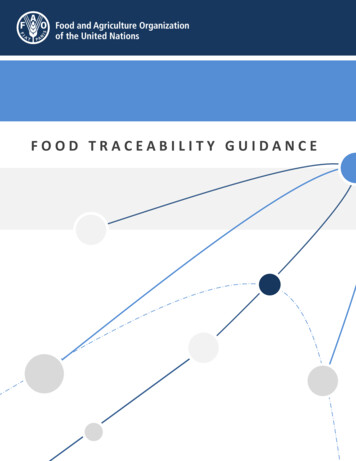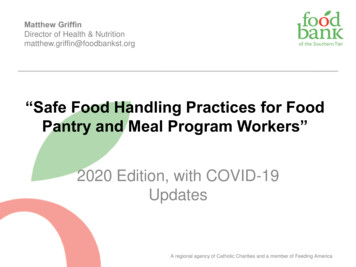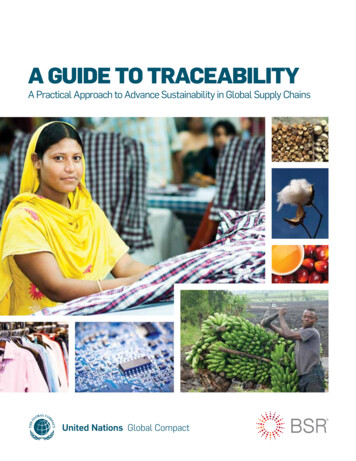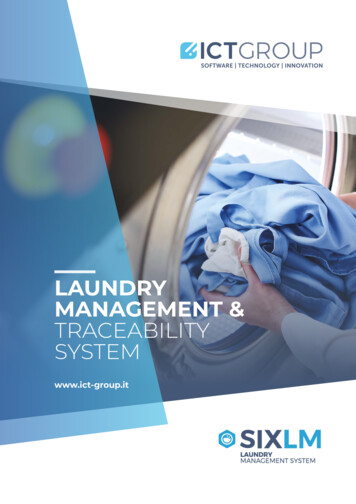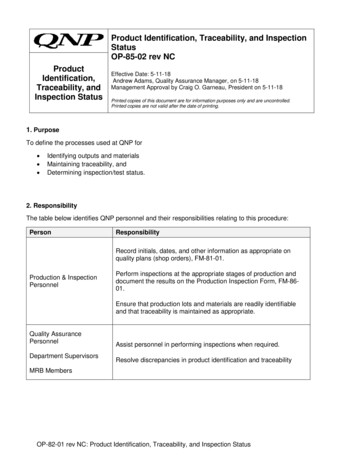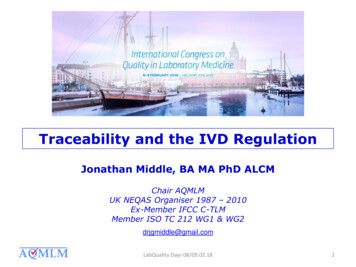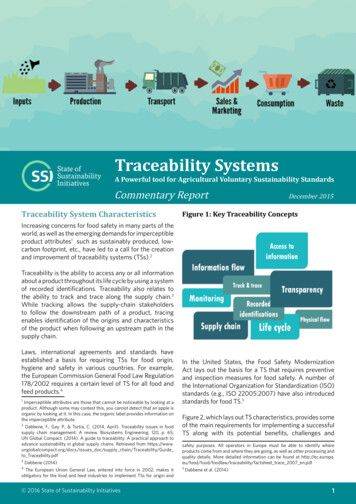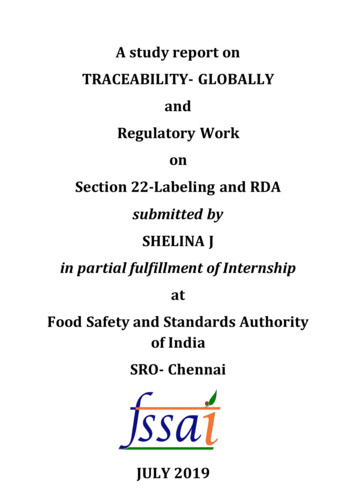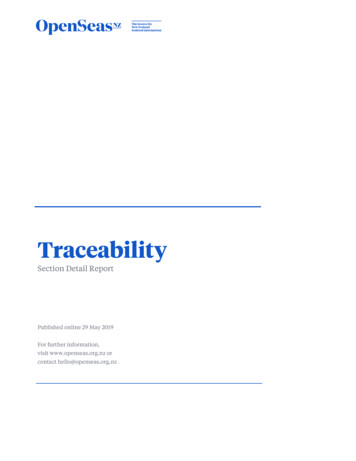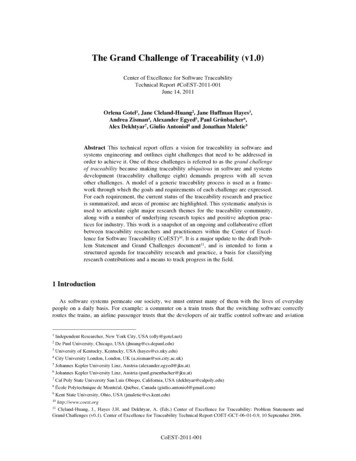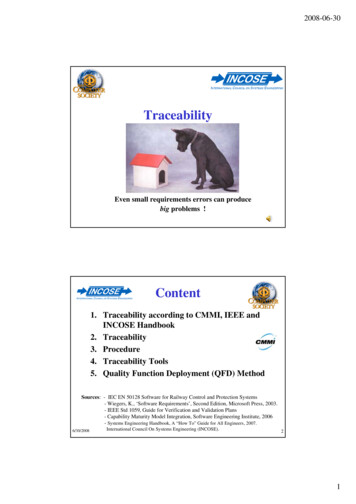
Transcription
FOOD TRACEABILITY,WITHDRAWALS AND RECALLSWITHIN THE UK FOOD INDUSTRYQUICK REFERENCE GUIDEJUNE 2019
INTRODUCTIONThis is a quick reference guide for food businesses. It complements the main guidance onFood Traceability, Withdrawals and Recalls within the UK Food Industry, which has beenproduced to explain the legal requirements in relation to food traceability, withdrawals andrecalls. The guidance can be found at:Food Standards AgencyandFood Standards ScotlandFOOD BUSINESSES’ RESPONSIBILITIESAs a Food Business Operator (FBO), you are responsible for the safety of the food whichyou produce, distribute, store or sell. You must:Not place unsafe food on the market (food is unsafe if it is injurious to healthor unfit for human consumption)Comply with food law in the production, distribution, storage and sale of foodBe able to trace suppliers of your food and the business customers thatyou have suppliedRemove unsafe food from the market in the event of a food safety incident2
TRACEABILITYTraceability helps keep track of food in the supply chain, which supports the accuratewithdrawal/recall of unsafe food, if required. The more information you keep, the easierand quicker it will be to identify the affected food, mitigate risks to consumers and save timeand money.WHAT THE LAW SAYSYou must have traceability information for your suppliers and businesscustomers (one step back and one step forward)Retailers, including caterers, are not required to keep traceabilityinformation where they sell to the final consumer. However, where theysupply food businesses, all traceability requirements must be adhered toLAWYou must have systems and procedures in place to allow for traceabilityinformation to be made available to enforcement authorities on demandYou must label or identify food placed on the market to facilitate itstraceabilityProducts of animal origin and sprouted seeds are subject to specifictraceability requirements.3
KEY STEPS IN DEVELOPING A FOOD TRACEABILITY SYSTEM1. THE SYSTEMYou must be able to trace food/ingredients purchased from suppliers and then supplied tobusiness customers (excluding food supplied to final consumer).2. DEFINING BATCHES OF FOODThis will help to ensure good traceability and can limit the amount of food to bewithdrawn/recalled.3. TRACEABILITY INFORMATION Business nameBusiness addressDescription of foods purchased and soldQuantitiesTransaction dates4. RECORD KEEPINGYou must ensure your traceability information can be made available on demand.BESTPRACTICEHAVE YOU ALSO THOUGHT ABOUT.? Trading with suppliers who have good traceabilitysystems in place Internal process traceability to enable you to matchup inputs and outputs and ensure better visibilitythroughout your supply chain Length of time to keep traceability information Periodically reviewing the traceability systemFor more information please refer to the TRACEABILITY section of the main guidance.4
FOOD WITHDRAWALS/RECALLSIf a food safety incident happens and the food has been supplied, it will have to be ‘withdrawn’and if necessary ‘recalled’.A withdrawal is the process by which unsafe food isremoved from the supply chain, where unsafe foodhas not yet reached the consumer.A recall is the process by which unsafe food isremoved from the supply chain and consumers areadvised to take appropriate action, for example toreturn or dispose of the unsafe food.WHAT THE LAW SAYSIf you believe a food that you have imported, produced, processed,manufactured or distributed is unsafe you should immediatelywithdraw and/or recall the food where it has left the immediatecontrol of your businessLAWYou must inform enforcement authorities, FSA/FSS, suppliers(if relevant), business customers and consumers (consumers only whena recall is necessary) of the food safety incident and necessary actions.5
MAKING A DECISION TO WITHDRAW OR RECALL FOODIn the event of a food incident, where the food has left your immediate control, you will needto determine if the food is unsafe and a course of action. The decision tree below outlines theprocess to follow.In some cases, you may be able to easily identify that a food is unsafe. However, not all hazardsthat might be found in food are specified in food safety regulations and therefore you may berequired to carry out a risk assessment.For more information on the decision-making process and carrying out risk assessments pleaserefer to the MAKING A DECISION TO WITHDRAW OR RECALL FOOD section of the mainguidance.6
INITIATING AND MANAGING A FOOD WITHDRAWAL/RECALLA number of key aspects need to be considered when initiating and managing afood ON Know the details ofthe problemKnow which productand which batchesare affectedCarry out riskassessment (ifnecessary)Stop supplyEnsure product iswithdrawn and, ifnecessary recalledKEY DECISIONLOG TEMPLATE:Downloadable throughlink below Inform enforcementauthorities, FSA/FSS, suppliers,business customersand consumers(if a recall isrequired)HANDLINGUNSAFE FOODMONITORINGPROGRESSNOTIFICATION Throughoutthe food safetyincident maintaincommunicationwith all relevantparties Label affectedfood clearly to showit should not be soldMake unsafe foodsafe if a productcan be re-workedor re-labelledDispose of unsafefood as wasteNOTIFICATIONTEMPLATES:1. Enforcement Authority2. Business to Business3. Allergy Alert Point of Sale Notice4. Food Recall Alert Point of Sale NoticeAll downloadable through link belowWithdrawals and recalls guidanceBESTPRACTICEHAVE YOU ALSO THOUGHT ABOUT.? Notifying consumer, allergy and patient support organisations Monitoring progress of and closing a withdrawal/recall Reviewing the effectiveness of the withdrawal/recall andcarrying out root cause analysisFor more information please refer to the INITIATING AND MANAGING A FOOD WITHDRAWAL/RECALL section of the main guidance.7
ROLES AND RESPONSIBILITIESFBO initiatingwithdrawal/recallNon-retailFBO receivingnotificationRetailer receivingnotification (inccaterers sellingprepacked food)CaterersreceivingnotificationStop supplyNotify relevant parties(enforcement authority,FSA/FSS, customers)Arrange for return/disposal of foodIdentify/label unsafe foodand dispose of or re-workRemove unsafe food fromsupply chain/sale/serviceAdvise business customerson actions to takeReturn unsafe food toFBO / disposePrepare and issue/sendPOS notificationRECALL ONLYInform consumers ofrecall / retrieve unsafe foodRECALL ONLYAccept return of affectedfood from consumersRECALL ONLYBESTPRACTICEHAVE YOU ALSO THOUGHT ABOUT.? Preparing additional communications material e.g. Q&A for consumers Checking that business customers are taking appropriate actionFor more information please refer to the ROLES AND RESPONSIBILITIES OF THOSE INVOLVEDIN A WITHDRAWAL/RECALL section of the main guidance.8
USEFUL CONTACTSTo stay up to date with information on food recalls/allergy alerts please see:For England, Wales and Northern IrelandFor ScotlandFSAIncidents Response TeamsEnglandTel: 020 7276 8448Email: foodincidents@food.gov.ukWalesTel: 02920 678961Email: wales.foodincidents@food.gov.ukNorthern IrelandTel: 02890 417700Email: incidents.ni@food.gov.ukOnline NotificationFSSScotlandScottish Food Crime and Incidents UnitTel: 01224 285138Email: incidents@fss.scotOnline Notification9
FOOD TRACEABILITY, WITHDRAWALS AND RECALLS. WITHIN THE UK FOOD INDUSTRY QUICK REFERENCE GUIDE. JUNE . 2019. 2 INTRODUCTION This is a quick reference guide for food businesses. It complements the main guidance on Food Traceability, Withdrawals and Recalls within the UK Food Industry, which has been produced to explain the legal requirements in relation to food
